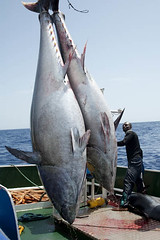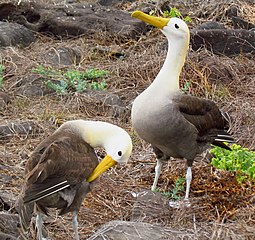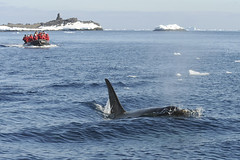 海洋覆蓋了地球表面的72%,具估計有25萬種海洋生物生存其間。聯合國秘書長潘基文在國際生物多樣性日發表的訊息中表示,「在人類的影響下,海洋的生物多樣性雖然如此重要卻逐漸喪失。」
海洋覆蓋了地球表面的72%,具估計有25萬種海洋生物生存其間。聯合國秘書長潘基文在國際生物多樣性日發表的訊息中表示,「在人類的影響下,海洋的生物多樣性雖然如此重要卻逐漸喪失。」
潘基文警告,超過一半的全球漁業資源已經衰竭,甚至有1/3已經完全耗盡。30-35%的海洋環境諸如海草、紅樹林及珊瑚礁已經被摧毀。
塑膠碎片持續導致海洋生物死亡,而由陸地排出的污染物在沿岸水域隔絕出廣大、缺乏氧氣的「死區」。
潘基文指出,「加上燃燒石化燃料對全球氣候的影響致使海水增溫造成海平面上升及海水酸化,我們才剛開始瞭解這些現象所產生的後果。」
為了增加對生物多樣性議題的瞭解與認知,聯合國大會指定每年的5月22日為國際生物多樣性日。今年的主題是海洋生物多樣性。
非營利組織國際鳥盟(BirdLife International)發現商業性漁業是目前對全世界的海鳥最大的威脅。包括了延繩釣船,拖網漁船和及流刺網都該為每年數十萬的海鳥死亡負責。
國際鳥盟表示:「對許多種類的信天翁而言,這樣的死亡率導致牠們族群量的不永續,使牠們瀕臨滅絕。另外,漁業過度捕撈造成即便是小魚都成為商業漁業的目標物,對海鳥的負面衝擊將持續增加。」
 世界自然保育聯盟(IUCN)鳥類紅皮書呈現近半數海鳥面臨族群量下降。開放海域鳥類情況特別嚴重,已知的346種海鳥中,97種為全球受威脅,17種名列極度瀕危。
世界自然保育聯盟(IUCN)鳥類紅皮書呈現近半數海鳥面臨族群量下降。開放海域鳥類情況特別嚴重,已知的346種海鳥中,97種為全球受威脅,17種名列極度瀕危。
潘基文表示,陸域有幾乎15%的面積是在各種保育規範中受保護,但是在海洋,「只有不到1%的海洋受到保護。」
「近來已有一些進展,特別在建立大尺度海洋保護區、及由生態及生物學的角度將重要的公海還有深海區地建檔。」
奧勒岡州州長John Kitzhaber21日簽署了一份法案指定境內3處海洋保留及保護區,這是奧勒岡州首次設立海洋保護區,也是近岸海洋保育上的新進展。這份法案提供動植物繁衍及茁壯成長的地方。
皮尤環境組織(Pew Environment Group)成員、「我們的海洋聯盟」(Our Ocean Coalition)負責人Susan Allen表示:「這是奧勒岡州歷史性的一刻;奧勒岡州的自然資源管理擁有悠長的歷史,本法案為自1967年具里程碑性質的奧勒岡海灘法案(Beach Bill)通過後,對奧勒岡州所轄海域最重要的法案。」我們的海洋聯盟組織包含了奧勒岡州的保育人士、科學家、海洋使用者及商業領袖。
在歐盟,今年國際生物多樣性日為期三天以海洋永續為中心的系列活動,命名為「藍色成長」(Blue Growth)。5月20日於瑞典的哥德堡辦理的海洋嘉年華揭開活動序幕,展出主題包括:海洋研究、海洋環境的威脅、氣候變遷效應、漁業、航運、港口的發展,海洋國家公園,海洋空間規劃,風力能源和波浪能。
歐盟海洋事務和漁業部執行委員會高層發言人Maria Damanaki於5月21日舉辦的研討會表示,「藍色成長有兩個目的:在海洋經濟中創造新的工作、讓海洋經濟合理及永續的成長。」
5月22日共有26個藍色成長的工作坊及展覽舉行,海洋事務利益相關者將展示涉及海洋的政策措施。
 不過IUCN及其他海洋保育團體警告,黑鮪魚、鱸魚及鱈魚在地中海區域已因過度捕撈及污染瀕臨滅絕。
不過IUCN及其他海洋保育團體警告,黑鮪魚、鱸魚及鱈魚在地中海區域已因過度捕撈及污染瀕臨滅絕。
特別值得關注的是IUCN列為頻危的大西洋黑鮪魚,消失速率比其他物種高出許多。報告中提及大西洋黑鮪魚因過度捕撈族群量已呈現歷史新低。IUCN警告在地中海地區將會有超過40種海洋魚類消失,包括許多魟魚和鯊魚。
拉姆薩溼地公約組織的秘書長Anada Tiéga提醒全球人類活動對海洋健康的直接影響。「據估計全世界約有60%的人居住在海岸區域,這會直接或間接施壓於海洋區永續,比方棲地喪失、污染增加、海平面上升、干擾水的流動及沉積物。上述這些問題會嚴重影響近岸濕地及它們繼續提供人們重要功能、維持生物多樣性的承載力。」
南極海洋聯盟的其中一個組織WWF,22日提出新的願景:設立含括南極海洋棲地、世界上最大的海洋保護區。WWF新發表的報告「南極海洋遺產:極圈保護視野」提出海洋是如此獨一無二的環境,呼籲各國政府支持海洋保育。
南極海域佔了全球海洋面積的10%,也是地球所剩最完整的環境之一。約有1萬多種生物如企鵝、海報及鯨魚棲息其間,但牠們仍受到商業捕魚及氣候變遷的影響。WWF的報告闡述由於它基本完好的特性,超過40%的南冰洋授權保護請求南極海洋生物資源保存委員會(CCAMLR)來保護本區。南極海洋生物資源保護委員會已同意今年及明年建立環繞南極洲的海洋保護區網絡。
WWF全球海洋主管John Tanzer表示:「在為時已晚前,全世界必須採取行動來保護我們的海洋繽紛的環境。在這個充滿日益嚴重的威脅的年代,大海需要各國政府及其他機構(如CCAMLR)的支持」
聯合國潘基文秘書長表示,即將於里約熱內盧召開的Rio+20將提供保衛海洋的契機。「Rio+20必須刺激聯合國、各國政府及其他伙伴開始行動來管理及保護海洋,以抑制過度捕撈魚類;擴大海洋保護區、減少海洋污染及氣候變遷的影響。透過國家、區域及全球各層級的行動,加強國際合作,我們可以達成愛知生物多樣性目標:為了我們想要海洋高度生物多樣性的未來,在2020年達成劃設10%的海洋及近岸區保護區。」
Oceans cover about 72 percent of Earth's surface area and there are an estimated 250,000 marine species. "Yet, despite its importance, marine biodiversity has not fared well at human hands," UN Secretary-General Ban Ki-moon said today in his message to mark the International Day for Biological Diversity.
More than half of global fisheries are exhausted and a further third depleted, warned the secretary-general. Between 30 and 35 percent of critical marine environments, such as seagrasses, mangroves and coral reefs, have been destroyed.
Plastic debris continues to kill marine life, and polluted runoff from land-based activities is deadening vast areas of coastal waters, leaving these dead zones without oxygen.
"Added to all of this," said Ban, "increased burning of fossil fuels is affecting the global climate, making the sea surface warmer, causing sea level to rise and increasing ocean acidity, with consequences we are only beginning to comprehend."
The UN General Assembly proclaimed May 22 as the International Day for Biological Diversity, to increase understanding and awareness of biodiversity issues. The theme for this year's observance is marine diversity.
Commercial fisheries are the most serious threat facing the world's seabirds, finds the nonprofit advocacy organization BirdLife International, which says fisheries are responsible for the incidental deaths of hundreds of thousands of seabirds each year. Longliners, trawlers and gillnetters are all to blame.
"For several species of albatross, this level of mortality is unsustainable and they are now perilously close to extinction," says BirdLife. "In addition, the negative impact of overfishing on seabirds continues to increase as fisheries target ever smaller fish."
The IUCN Red List Index for birds shows that nearly half of seabird species are known or suspected to be experiencing population declines. Open ocean bird species are faring particularly badly. Of the 346 known seabird species, 97 species are globally threatened, while 17 are listed as Critically Endangered.
Secretary-general Ban says that on land nearly 15 percent of surface area is under some kind of protection, but at sea, "little more than one percent of marine environments are protected."
"Lately, some progress is being made, particularly with the establishment of large-scale marine reserves and documenting areas of ecological or biological significance in open-ocean and deep-sea habitats," he said.
On Monday, Oregon Governor John Kitzhaber made some progress in protecting coastal waters as he signed legislation designating three marine reserves and protected areas off Cape Falcon, Cascade Head, and Cape Perpetua, creating Oregon's first system of marine reserves.
Combined with two new sites designated in January, the law creates an initial network of marine reserves and protected areas off the Oregon coast to provide places for plants and animals to reproduce and thrive.
"This is a historic day for Oregon," said the Pew Environment Group's Susan Allen, who directs the Our Ocean Coalition, a statewide association of Oregon conservationists, scientists, ocean users and business leaders. "Our state has a long history of natural resources stewardship. This is the most important law to protect our Territorial Sea since the landmark Beach Bill of 1967."
In the European Union, the International Day for Biological Diversity was marked with a three day series of events centered on sustainable activities for oceans and seas called "Blue Growth."
The starting point was Sunday with a maritime festival in Gothenburg, Sweden. Exhibits focused on: maritime research, threats to the sea environment, the effects of climate change, fishing, shipping, the development of harbors, marine national parks, maritime spatial planning, wind and wave energy.
On Monday, the conference hosted high-level key speakers such as Maria Damanaki, European Commissioner for Maritime Affairs and Fisheries, who said, "The dual purpose of Blue Growth [is] creating new jobs in the maritime economy and letting maritime economy grow, but sustainably and inclusively."
Today, there were 26 Blue Growth workshops and an exhibition area, where maritime stakeholders showcased policy initiatives related to seas and oceans.
But the International Union for the Conservation of Nature, which maintains the authoritative Red List of Threatened Species, and other marine conservation organizations have warned that bluefin tuna, sea bass and hake are threatened with regional extinction in the Mediterranean Sea because of overfishing and pollution.
Concern is particularly high over the disappearance of the Atlantic bluefin tuna, Thunnus thynnus, which the IUCN lists as Endangered, saying, "This species has become rare relative to historical levels because of massive overfishing." More than 40 species of marine fish could disappear from the Mediterranean, including many rays and sharks, warns the IUCN, .
Secretary-general of the Ramsar Convention on Wetlands, Anada Tiéga, reminded the world of the direct impact of human activities on ocean health.
"An estimated 60 percent of the world's human population live on or close to the coast, which is directly or indirectly causing many stresses affecting sustainability in the coastal zone, such as loss of habitat, increased pollution, accelerated sea-level rise, and interruption of flow of water and sediments," said Tiéga.
"Many of these problems seriously affect coastal wetlands and their capacity to continue to provide vital functions for people and biodiversity in these areas," Tiéga said.
The global conservation organization WWF, as part of the Antarctic Ocean Alliance, today unveiled a new vision for the creation of the world's largest marine protected area across Antarctic marine habitats.
The new report, "Antarctic Ocean Legacy: A Vision for Circumpolar Protection" calls on governments to support increased marine protection for this unique environment.
Visitors to Antarctica go on a whale watching excursion in a motorized inflatable. (Photo by Alumni Western)
Antarctic waters make up almost 10 percent of the world's seas and are some of the most intact environments left on Earth. They are inhabited by almost 10,000 diverse species such as penguins, seals and whales, yet they are under increasing pressure from commercial fishing and climate change.
The WWF report says that over 40 percent of the Southern Ocean warrants protection and is calling on the Commission for the Conservation of Antarctic Marine Living Resources, to protect this area now while it remains largely intact.
CCAMLR has agreed to create a network of marine protected areas around Antarctica this year and next.
"The world must act now to conserve our diverse marine environment before it is too late," said John Tanzer, global marine director, WWF International. "The oceans need all the support governments and bodies such as CCAMLR can give in this era of increasing threats."
Secretary-general Ban said that next month Rio+20, the UN Conference on Sustainable Development in Rio de Janerio, Brazil, will provide an opportunity to safeguard the oceans.
"Rio+20 must galvanize action to improve the management and conservation of oceans through initiatives by the United Nations, governments and other partners to curb overfishing, expand marine protected areas and reduce ocean pollution and the impact of climate change," Ban said.
"By taking action at the national, regional and global levels, including enhancing international cooperation," said Ban, "we can achieve the Aichi Biodiversity Target of conserving 10 percent of marine and coastal areas by 2020, a crucial step in protecting marine biodiversity for the future we want."





